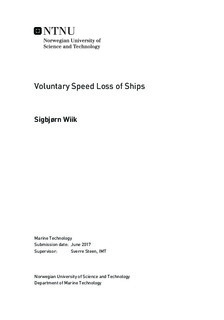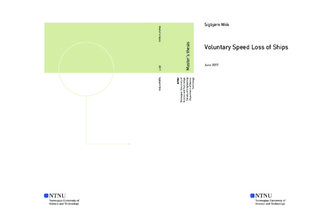| dc.description.abstract | When a ship is caught in heavy seas, speed loss follows. This thesis focuses on the subjective part of speed loss; voluntary speed reductions to maintain the safety of the ship, the cargo and the people. The objective is to establish reasonable operability limits to objectionable motions that jeopardize the safety. Although the ideas presented in this thesis are intended to be general- ized for any ship, only single-hull surface displacement vessels operating in typical port-to-port missions are considered.
Factors that degrade the ship performance, and thus the operability, can be governed by prescribing operability criteria that are set to an acceptable and an unacceptable level. These operability criteria and their influencing factors as well as their significance will be investigated in this thesis.
A literature research was conducted to find current operability criteria of a ship. Individual studies were then conducted to verify or find new operability limits. This was done in three ways: First, a questionnaire to look at the subjectivity involved as well as verifying that oper- ability criteria from literature are valid for the type of ship investigated. Second, through ship service investigation to look at actual trends for sea-going vessels, the likelihood of a volun- tary speed loss for a given sea state, the amount of speed loss, and whether it was possible to generalize results. Lastly, the operability criteria found in literature and the questionnaire were implemented in numerical analyses to validate the limiting operability criteria.
From the questionnaire, it was found that voluntary speed loss would become prominent for significant wave height around 5.5 meters in a loaded and ballasted condition for head and beam seas. In following sea, voluntary speed losses become prominent at higher wave heights; around 10 meters. The questionnaire also highlighted a larger tolerance for root mean square roll angle, water on deck and slamming and lateral acceleration. However, with very varying results it was impossible to set operability criteria from the questionnaire. Human comfort was not indicated as a limiting factor in the questionnaire, yet from numerical calculations it was found that motion sickness incidences (MSI) was the operability criteria that dictates safe speed in both head and beam seas. In following seas, numerical results showed that propeller racing was the single most important factor inducing a voluntary speed loss.
As no responses were recorded in the ship service data, it was impossible to set operability criteria from it. However, the ship service data gave valuable information about inception and occurrence of voluntary speed loss. It showed that a voluntary speed loss is likely to occur for significant wave height around 5.5 meters, although ship differences occur, varying from wave height of 4-10 meters.
Both the questionnaire and service data encompass approximately similar ship type and size. 24 of 26 answers from the questionnaire were received on general cargo vessels, and the ship service data only contains general cargo vessels. The general dimension varies in length from 180-230 meters, width of 29-32 meters and depth/draft of 10-35 meters.
The ship service data and questionnaire data show good correlation, yet it must be empha- sized that general operability criteria were found to be highly dependent on ship size, type, heading, area of operation and type of mission.
From service data it was found that vessels sailing in significant wave height larger than 3 meters consists approximately of 11% of the time. For significant wave height around 5.5 meters, the time is only 4.6%.
Numerical calculations showed a higher importance of MSI in head and beam seas, and pro- peller racing in following seas. More calculations should be done though, as the questionnaire and service data was prioritized in this thesis.
With the high subjectivity involved, one of the most important factors found was that ev- erything on board must feel safe (for the master), regardless of the actual situation. As the master holds the most responsibility, the action of lowering the ship-speed is dependent on a master s experience, preference, perception of the situation and willingness to expose the ship to hazardous situations.
It is also important to emphasize that there is no guarantee that a speed loss will occur when exceeding the operability criteria. The service data showed that although sailing in conditions that normally yield voluntary speed loss, it is highly dependent on vessel. This thesis shows however that a voluntary speed loss is likely to occur for a significant wave height around 5.5m for a general cargo ship with dimensions as previously stated. The average voluntary speed loss is around 5 knots. This limit is however very questionable as there are large differences in answers received from the questionnaire and ship service data.
Considering the relatively few responses from the survey, one should be careful in transfer- ring results, especially to other ship types.
More research should be done on specific ship types, as well as getting an increased trend of more ship service monitoring where responses are recorded. This will make it possible to find feasible operability criteria from ship service data. | |

